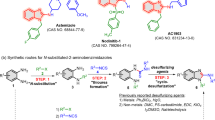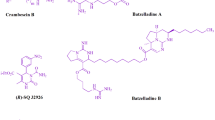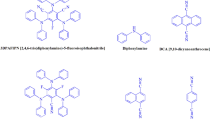Abstract
Following the observation by Fulton and Yorke1 that the drug Stilbamidine (4: 4´-diamidinostilbene di-β-hydroxyethanesulphonate) undergoes photochemical change with production of a more toxic substance when its solutions are exposed to light, various investigators have put forward suggestions regarding the constitution of the irradiation product. Barber, Slack and Wien2 reported that “The product is almost certainly 4: 4´-diamidinophenylbenzyl carbinol, but rigorous proof is difficult”. Goodwin3, from spectrographic evidence, confirmed that saturation of the ethylenic linkage occurs, while Henry4 reported that a number of chemical changes are involved, including dimerization.
This is a preview of subscription content, access via your institution
Access options
Subscribe to this journal
Receive 51 print issues and online access
$199.00 per year
only $3.90 per issue
Buy this article
- Purchase on SpringerLink
- Instant access to full article PDF
Prices may be subject to local taxes which are calculated during checkout
Similar content being viewed by others
References
Fulton, J. D., and Yorke, W., Ann. Trop. Med. Parasitol, 36, 134 (1942).
Barber, H. J., Slack, R., and Wien, R., Nature, 151, 107 (1943).
Goodwin, T. W., Ann. Trop. Med. Parasitol, 37, 59 (1943).
Henry, A. J., Nature, 152, 690 (1943).
Ciamician, G., and Silber, P., Ber., 35, 4128 (1902).
Robertson, J. M., and White, J. G., J. Chem. Soc., 607 (1945).
Author information
Authors and Affiliations
Rights and permissions
About this article
Cite this article
FULTON, J., DUNITZ, J. Constitution of the Irradiation Product from Stilbamidine. Nature 160, 161–162 (1947). https://doi.org/10.1038/160161a0
Issue date:
DOI: https://doi.org/10.1038/160161a0
This article is cited by
-
Die Infrarot-Absorption des cis-Stibens im Valenzschwingungsgebiet
Die Naturwissenschaften (1961)



